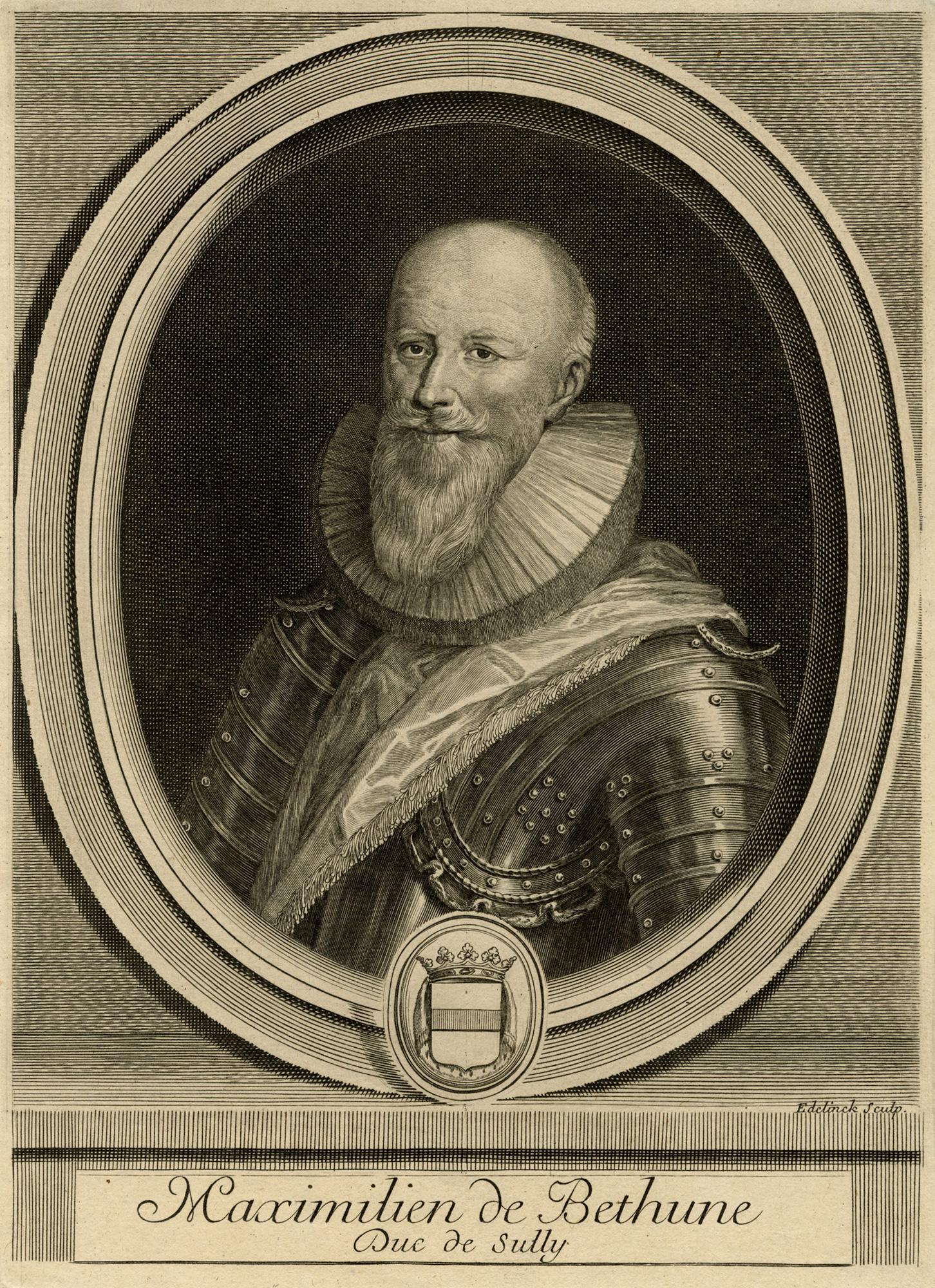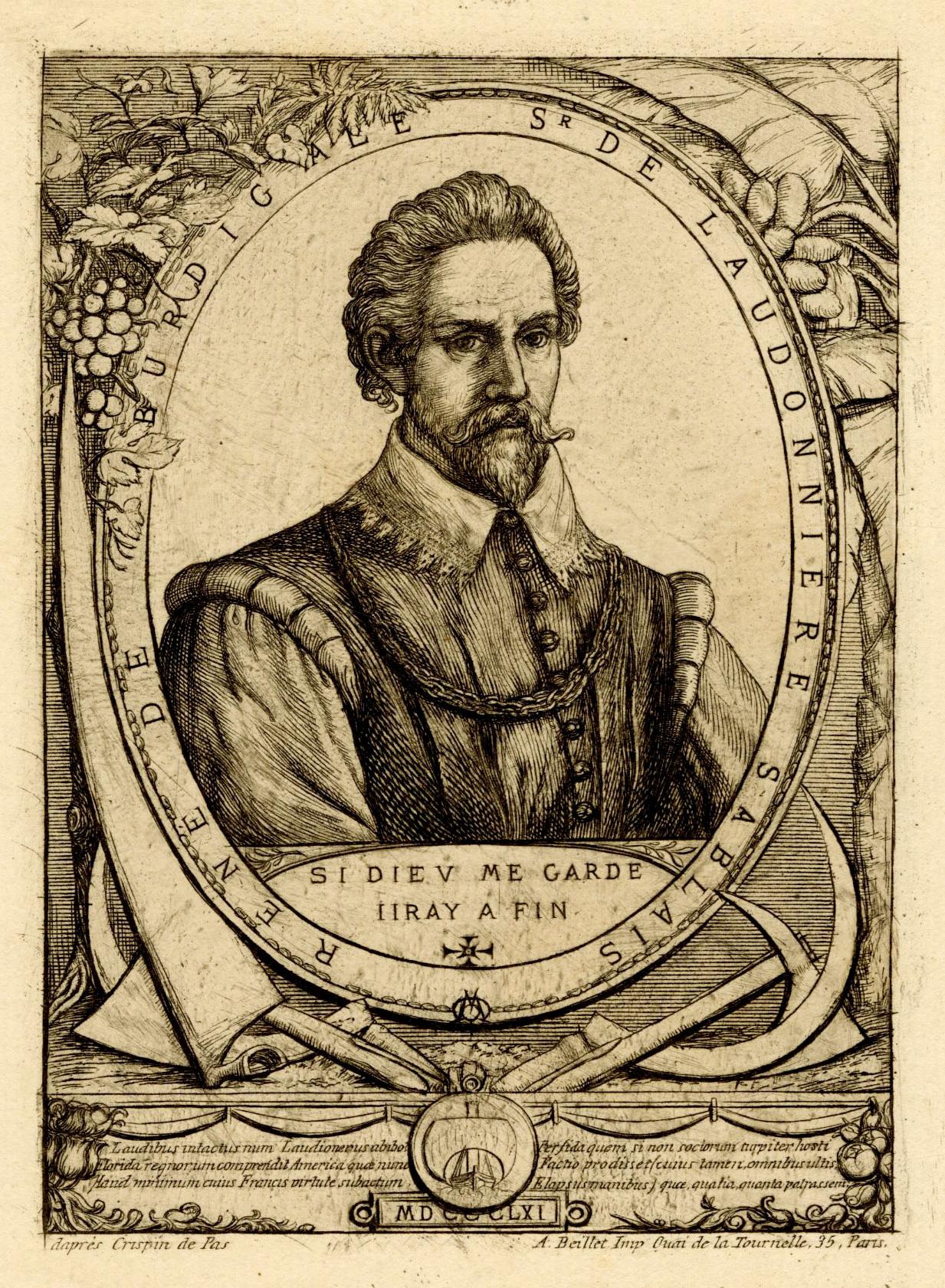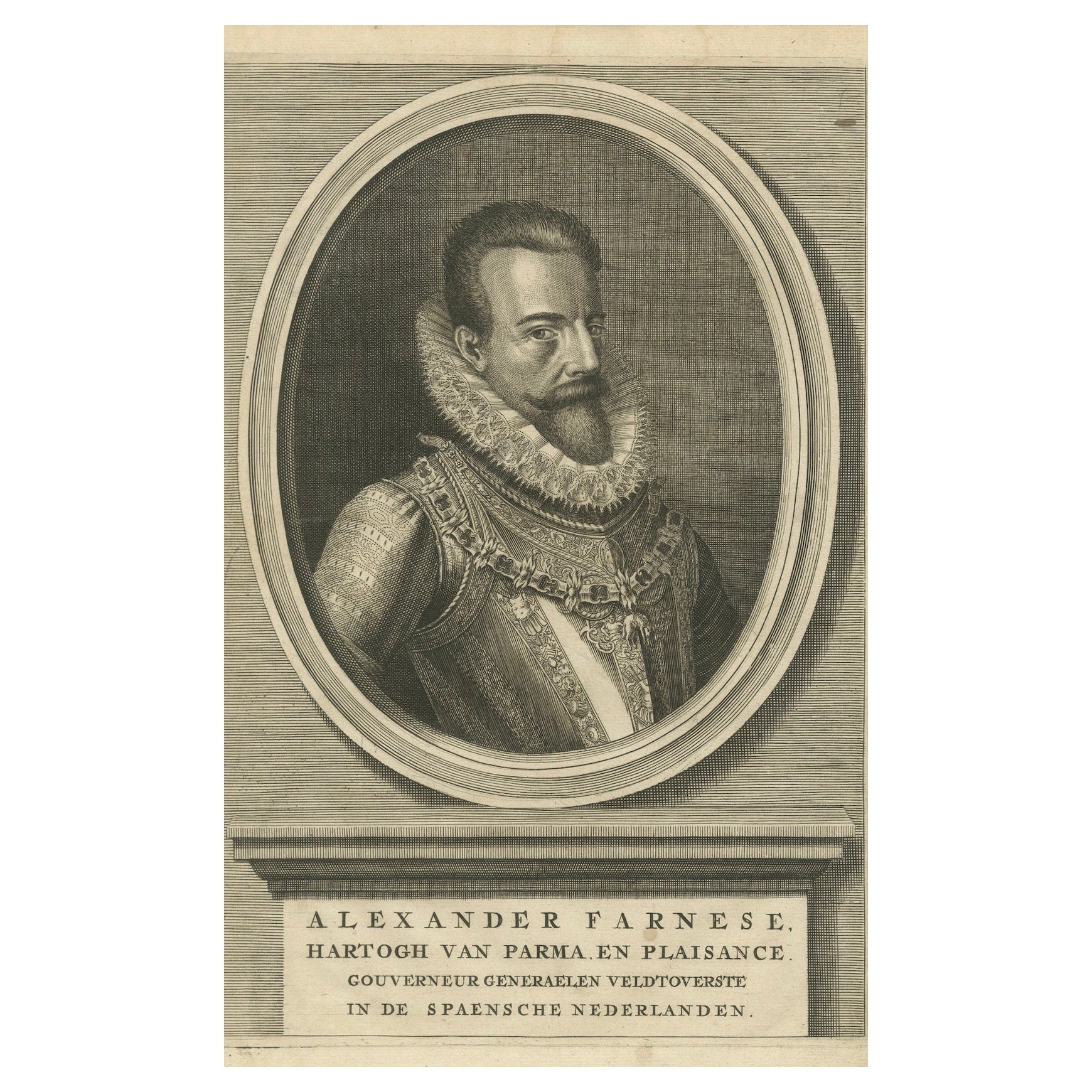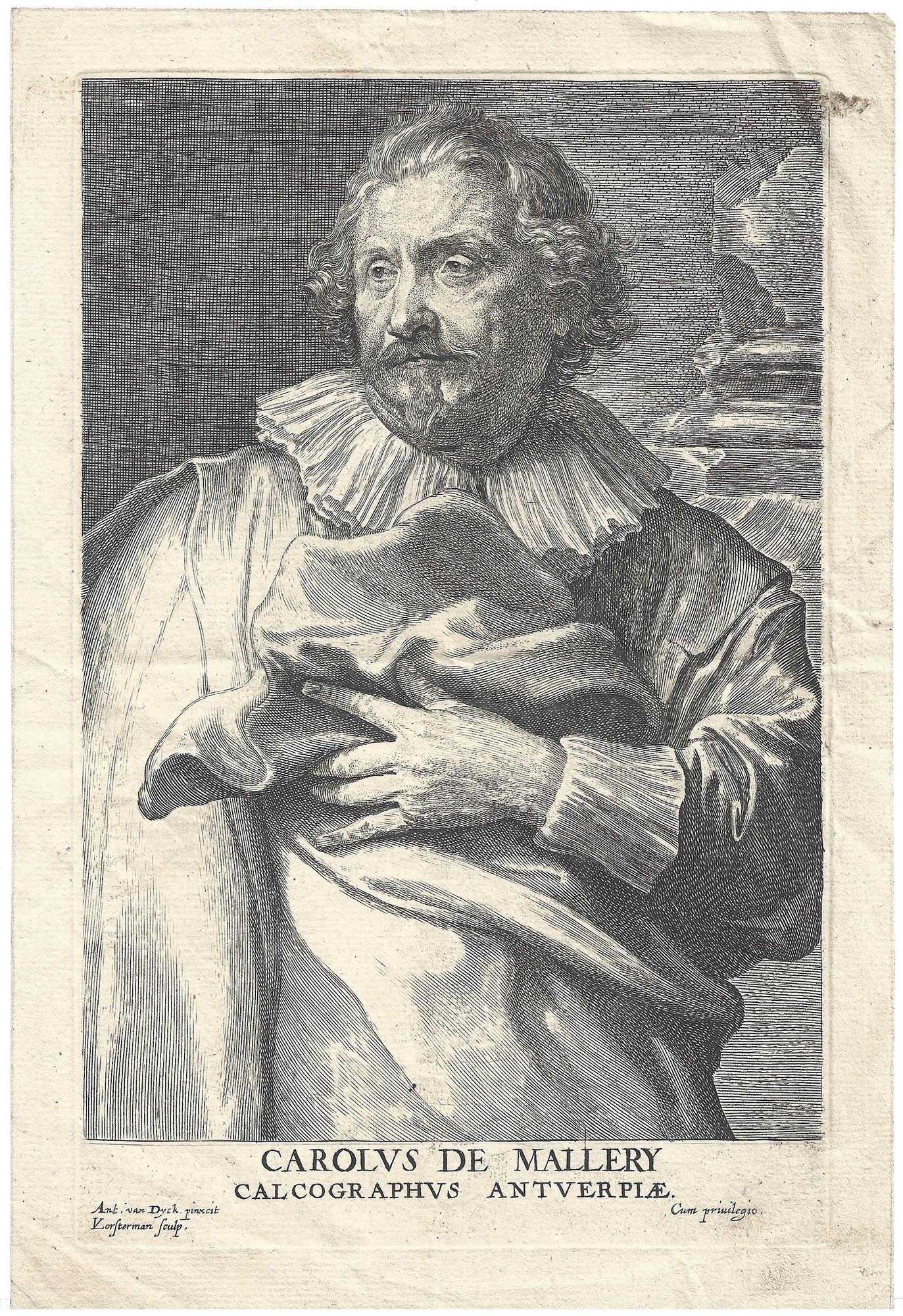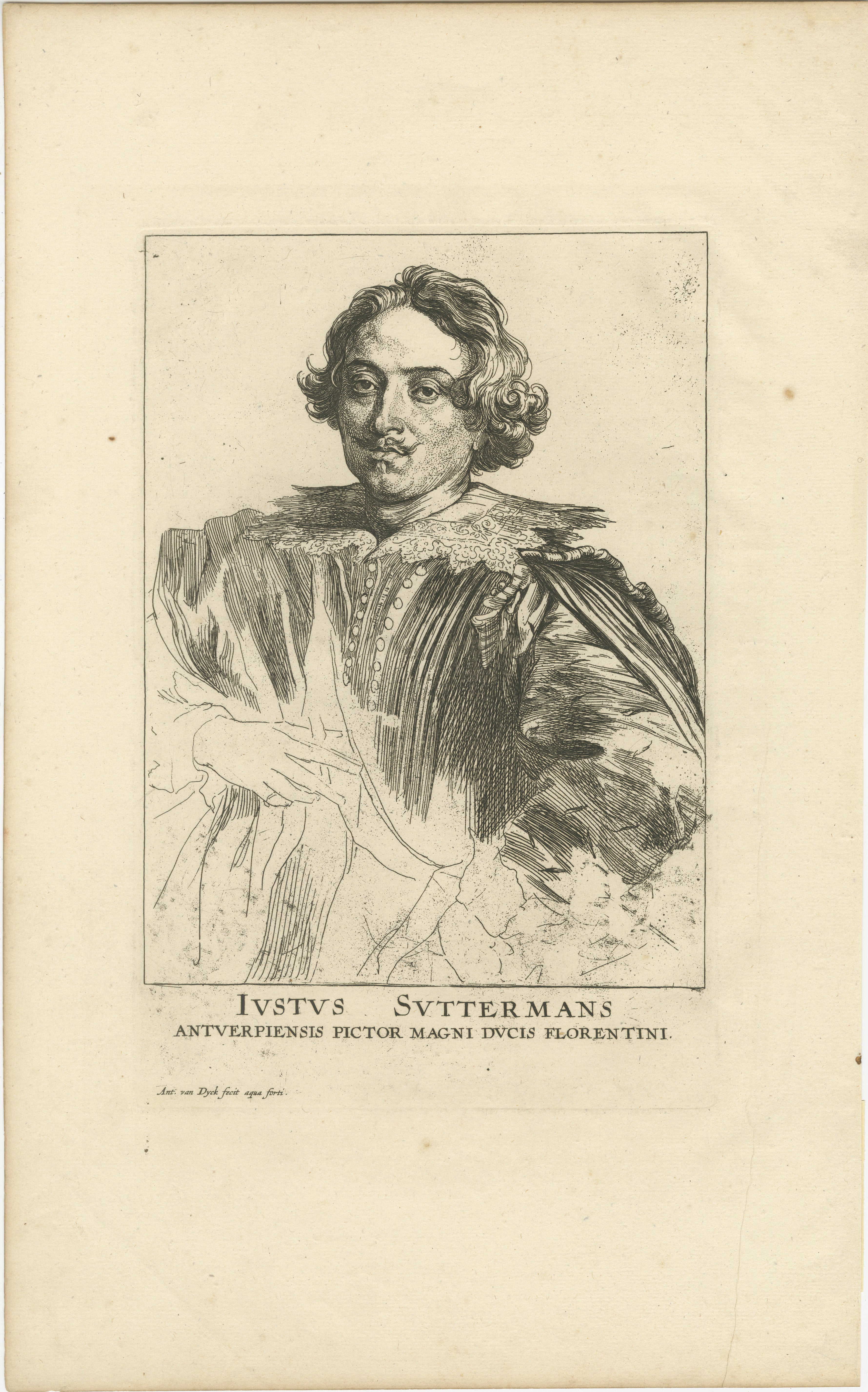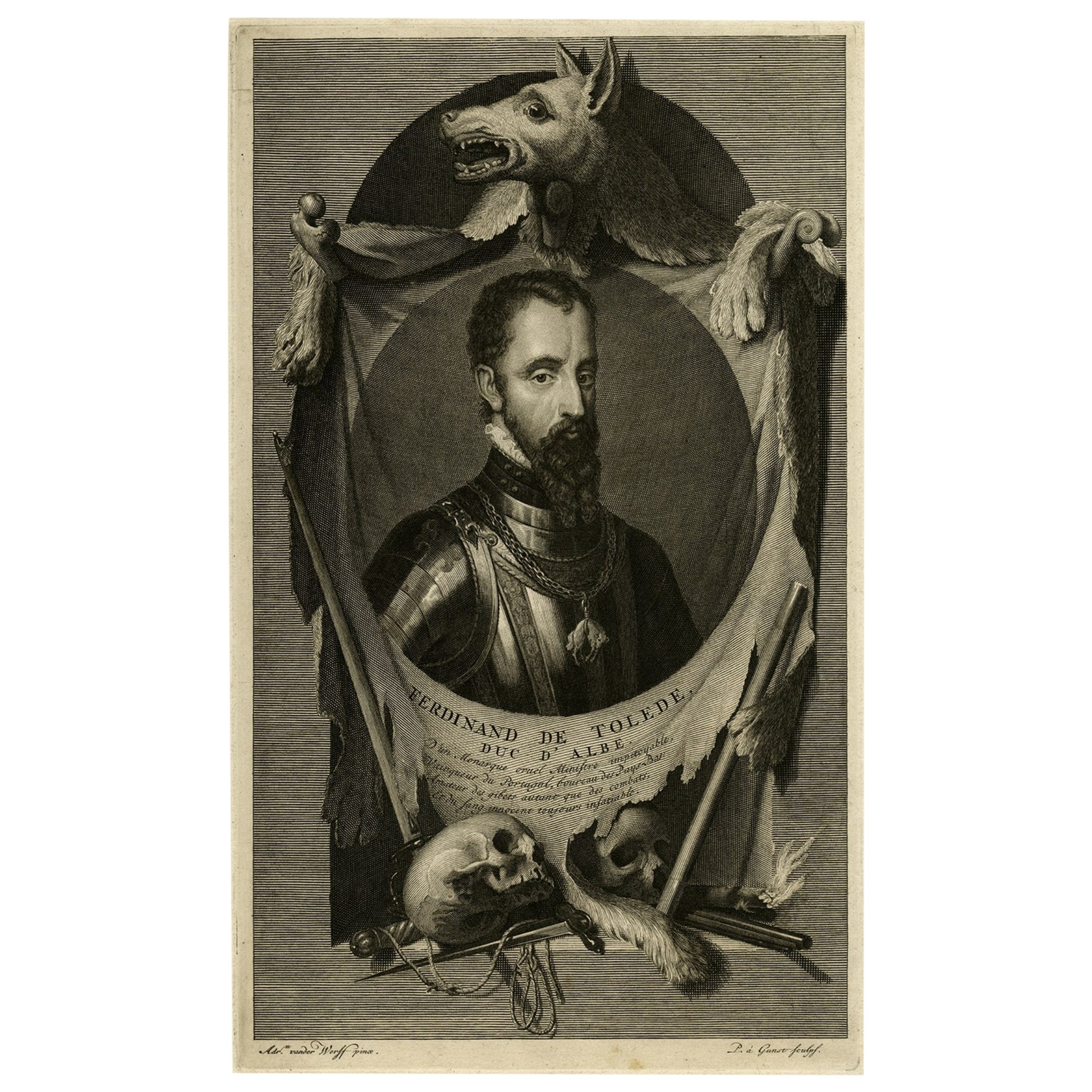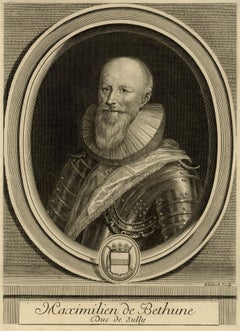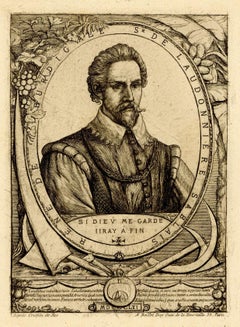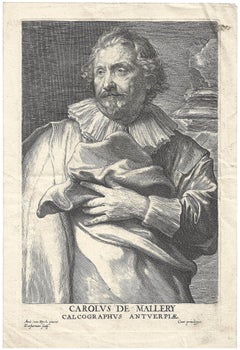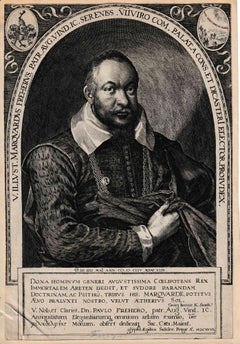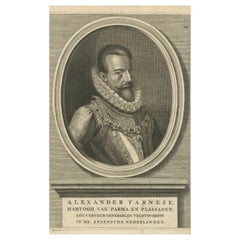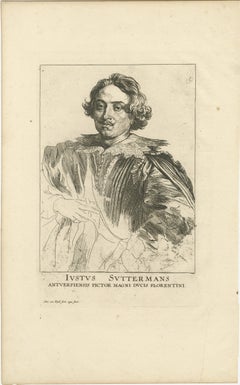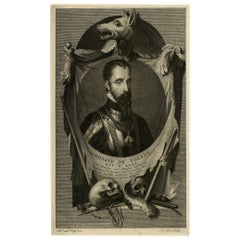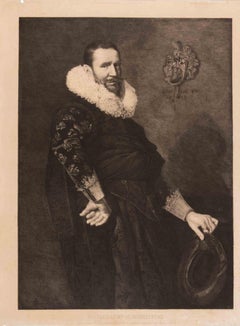Items Similar to Portrait of Carlos de Colonna, Marques de la Espinar
Want more images or videos?
Request additional images or videos from the seller
1 of 2
Paulus PontiusPortrait of Carlos de Colonna, Marques de la Espinarcirca 1650
circa 1650
$500
£389.37
€442.90
CA$720.08
A$790.20
CHF 412.73
MX$9,447.74
NOK 5,227.91
SEK 4,876.01
DKK 3,307.87
About the Item
(after Anthonie Van Dyck) Engraving on cream laid paper, 9 1/4 x 6 3/8 inches (234 x 161 mm), full margins. Water stain throughout bottom, diagonal creases in the area of the bottom right corner, paper tape along top edge on recto. A very well inked impression.
__________Flemish painter and engraver Paulus Pontius was born in Antwerp in 1603, and it was in this city that his full life would unfold. At the young age of 13, he was apprenticed to the still life painter Osias Beert, and subsequently to Lucas Vosterman, who was heavily associated with the workshop of Peter Paul Rubens. Vosterman trained Pontius in the skill of engraving, which he took to immediately, finding he had great skill at recreating paintings. Pontius was able to capture the minutiae of light and shadow found on the canvas, and mastered the ability to accurately render the subtleties of brushwork in this alternate media. His success as an engraver cemented his role in the workshop of Rubens, and in 1624, when Vosterman found himself at odds with Rubens, and left Antwerp for England, Pontius assumed his role as foremost engraver in the workshop. It was in this year that Pontius took up lodgings in Rubens's home, and continued to live there until 1631, when courtship and marriage (the first of three) brought him away. After the death of Rubens in 1640, Pontius embarked on a very successful career engraving reproductions of master works by artists including Rubens, Anthony van Dyck, Jacob Jordaens, Pieter van Avont, Abraham van Diepenbeeck, Anselm van Hulle, Frans Luycx, Titian and Velázquez, among others. At the time of his death in 1658, Pontius had been admitted as a Master in the Antwerp Guild of Saint Luke, had engraved 42 plates after Rubens, 32 plates by Van Dyck (including a portrait of himself), and was father to seven children. Many of his portrait engravings were widely published during his lifetime, including in van Dyck's Iconography (Antwerp, c. 1632–44), Johannes Meyssens' Images de divers hommes, and Anselm van Hulle's Icones legatorum (Antwerp, 1648).
- Creator:Paulus Pontius (1603 - 1658, Flemish)
- Creation Year:circa 1650
- Dimensions:Height: 9.25 in (23.5 cm)Width: 6.38 in (16.21 cm)
- Medium:
- Movement & Style:
- Period:Mid-17th Century
- Condition:
- Gallery Location:Middletown, NY
- Reference Number:Seller: BH1461stDibs: LU1979211156522
About the Seller
5.0
Vetted Professional Seller
Every seller passes strict standards for authenticity and reliability
Established in 2004
1stDibs seller since 2022
76 sales on 1stDibs
Typical response time: 1 to 2 days
- ShippingRetrieving quote...Shipping from: Middletown, NY
- Return Policy
More From This Seller
View AllMaximilien de Bethune, Duc de Sully
By (After) Frans Pourbus the Younger
Located in Middletown, NY
A portrait of Maximilien de Bethune, Duc de Sully, the Ambassador from Henry IV of France to James I of England; by Gerard Edelinck, after Franz Pourbus the Younger
Etching on fine ...
Category
Late 17th Century Old Masters Portrait Prints
Materials
Laid Paper, Etching
René de Laudonnière Sablais (de Burdigale). After Crispjin van de Passe I
By Charles Meryon
Located in Middletown, NY
Paris: 1861
Etching, drypoint, and engraving on cream laid paper, 6 x 4 1/4 inches (152 x 108 mm), full margins. Dog-eared left corner, extending 3-inches into the sheet, but well ou...
Category
Mid-19th Century French School Portrait Prints
Materials
Laid Paper, Engraving, Drypoint, Etching
Carolus de Mallery, by Lucas Vorsetman the Elder after van Dyck
By Rembrandt van Rijn
Located in Middletown, NY
An exalted portrait of fellow Flemish engraver and publisher Karel van Mallery.
Lucas Vorsterman the Elder (after Anthony van Dyck).
Carolus de Mallery, from Icones Principum Viror...
Category
Mid-17th Century Old Masters Portrait Prints
Materials
Laid Paper, Engraving, Etching
Portrait of Marquard Freher, aged forty-nine
By Aegidius Sadeler
Located in Middletown, NY
Engraving on hand made laid paper, 8 1/2 x 5 7/8 inches (210 x 148 mm), thread margins. An approximately 1-inch vertical repaired tear extends into the image area at the top center ...
Category
Early 17th Century Old Masters Portrait Prints
Materials
Handmade Paper, Laid Paper, Engraving
Portrait of Jacob Cats, poet – engraved by Michiel Nöel Natalis
Located in Middletown, NY
Amsterdam: Francois Halma, circa 1700.
Engraving on laid paper, 13 x 7 3/4 inches (350 x 197 mm); sheet 15 3/4 x 9 3/4 inches (400 x 248 mm), full margins. In very good condition wi...
Category
Early 18th Century Old Masters Portrait Prints
Materials
Laid Paper, Engraving
Jan Cornelis Sylvius
By Rembrandt van Rijn
Located in Middletown, NY
Heliogravure on cream laid paper, 6 1/2 x 5 1/2 inches (164 x 138 mm), thread margins. Uniform toning on the recto, and scattered light foxing and various notations in purple ink and...
Category
19th Century Old Masters Portrait Prints
Materials
Handmade Paper, Laid Paper, Etching
You May Also Like
Antique Portrait Alexander Farnese – Spanish Netherlands Governor, c. 1750
Located in Langweer, NL
Antique Portrait Alexander Farnese – Spanish Netherlands Governor, c. 1750
This finely executed 18th-century etching portrays Alexander Farnese (1545–1592), Duke of Parma and Piacen...
Category
Antique Mid-18th Century Dutch Prints
Materials
Paper
Portrait of Justus Sustermans, Flemish Painter to the Grand Duke of Florence
Located in Langweer, NL
Title: Portrait of Justus Sustermans, Flemish Painter to the Grand Duke of Florence
Description:
This is an antique engraving of Justus Sustermans (1597-1681), a renowned Flemish Baroque portrait painter born in Antwerp and active primarily at the Medici court in Florence. The engraving shows Sustermans half-length, wearing a richly detailed buttoned robe with a lace collar, with his hair in loose curls, and his right hand resting elegantly. Below the portrait is inscribed:
IVSTVS SVTTERMANS ANTVERPIENSIS PICTOR MAGNI DVCIS FLORENTINI
This Latin inscription identifies him as Justus Sustermans of Antwerp, painter to the Grand Duke of Florence. The engraving is after Anthony van Dyck, noted by the line at bottom left "Ant: van Dyck fecit aqua forti," indicating that van Dyck created the etching in the early to mid-17th century as part of his famous 'Iconography' series, portraying fellow artists and prominent individuals.
This engraving is after Anthony van Dyck’s etched portrait of Justus Sustermans from his Iconography series, originally etched by van Dyck circa 1630–1641.
However, this specific print is not an original van Dyck etching...
Category
Antique Early 18th Century European Prints
Materials
Paper
Portrait of Fernando Alvarez de Toledo y Pimentel, Grand duke of Alba, c.1690
Located in Langweer, NL
Antique print, titled: 'Ferdinand de Tolede. Duc d'Albe.'
Portrait of Fernando Alvarez de Toledo y Pimentel, Grand duke of Alba (1507-1582). Source un...
Category
Antique 1690s Prints
Materials
Paper
$488 Sale Price
20% Off
Portrait of Paulus van Beresteyn after Frans Hals - Etching - 19th Century
Located in Roma, IT
Portrait of Paulus Van Beresteyn after Frans Hals is original print realized by Lucien Quarante (1880-1902)
Etching on paper.
Good conditions with foxing.
Titled on the lower centre.
Category
19th Century Modern Figurative Prints
Materials
Etching
Sir Thomas Smyth, portrait engraving, c1820
By Jacobus Houbraken 1
Located in Melbourne, Victoria
Copper-line engraving by Jacobus Houbraken (1698-1780) after Holbein.
Houbraken was a Dutch engraver famous for his series of portraits of famous English historical figures with elaborate cartouches.
Originally published 1739, this impression c1820.
360mm by 230mm (platemark)
Sir Thomas Smythe...
Category
Early 19th Century Renaissance Portrait Prints
Materials
Engraving
Portrait of an Officer, Cornelius Johnson, 17th Century Old Masters
By Cornelius Johnson
Located in London, GB
Circle of Cornelius Johnson
Circa 1620’s
Portrait of a Officer
Oil on canvas
Image size: 28 x 24 inches
Period style hand made frame
Provenance
Private European Estate
This striking portrait dates to around 1620, as you can see from the images of the sash the detail is very high. The sash is decorated with gold thread and would have cost a small fortune at the time. Sashes were originally developed for a military function (making officers more visible for their men during combat), but soon became a primarily male fashion...
Category
Early 17th Century Old Masters Portrait Paintings
Materials
Oil
More Ways To Browse
Andy Warhol Liz
Andy Warhol Myths
Bailey Pin Ups
Bernard Buffet Clown
F Bartolozzi
Louis Dali
Modigliani Lithograph
Original Paul Cezanne
Picasso Portrait Jacqueline
Robert Weil
Russell Young Marilyn Crying
Sitting Bull Art
1952 Matisse Lithograph
Basquiat Signed Print
Bernard Buffet Clown Lithograph
Chuck Close Self Portrait
Picasso Maternite
Rbg Art
